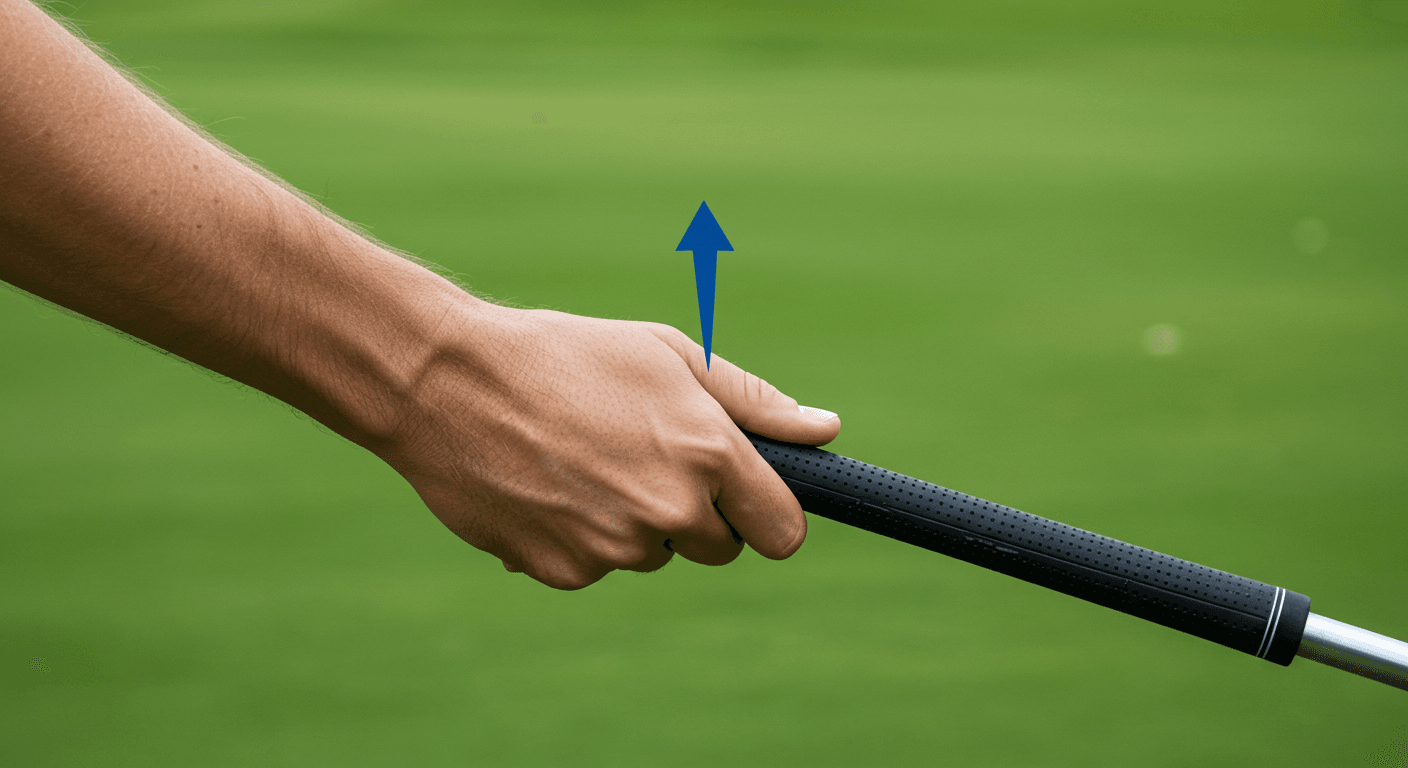Top Takeaways and Key Concepts
→ Master your grip technique to build control, comfort, and consistency with every swing.
→ Adopt a balanced stance with proper foot placement and alignment for improved accuracy.
→ Refine your backswing by keeping smooth movement and steady rhythm for controlled power.
→ Perfect your downswing by shifting weight forward and rotating confidently through impact.
→ Practice smart drills regularly to strengthen muscle memory and improve swing performance.
Summary of This Article
This article explains how to master your golf swing through grip, stance, and controlled motion. It breaks down each phase—from backswing to follow-through—into practical, easy-to-follow tips. Readers learn how balance, rhythm, and regular drills create consistent power and precision, helping golfers at any level play with confidence and enjoyment.
Video Summary
Please Note: This post may contain affiliate links. If you click one of them, we may receive a commission at no extra cost to you. As an Amazon Associate, I earn from qualifying purchases.
Golf is a game of precision, patience, and practice. If you’ve ever watched a professional golfer swing their club, you might have thought, “How do they make it look so easy?” Well, spoiler alert: It’s all about mastering the right golf swing techniques! Whether you're just starting out or looking to refine your skills, understanding these techniques can help elevate your game from “meh” to “wow!” Let’s dive into some essential swing techniques that can transform your golfing experience.
The Grip: Your Foundation for Success
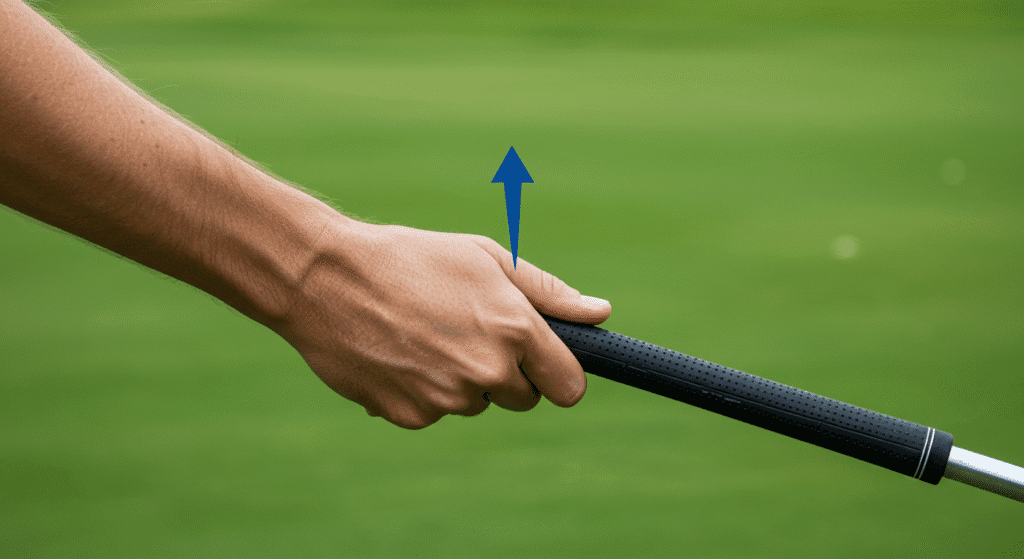
Gary Player: “The more I practice, the luckier I get.“
The grip is where everything begins. Imagine trying to bake a cake without measuring the ingredients—chaos! Similarly, if your grip isn't right, you're setting yourself up for failure before you even take the shot. A proper grip involves holding the club firmly but not too tightly; think of it as holding a baby bird—gentle yet secure!
You’ll want to position your hands correctly on the club, and believe me, this is where it all begins! A proper grip sets the foundation for a successful swing. For most players, this means choosing between an overlapping grip or an interlocking grip. Each has its unique advantages, so let’s break them down.
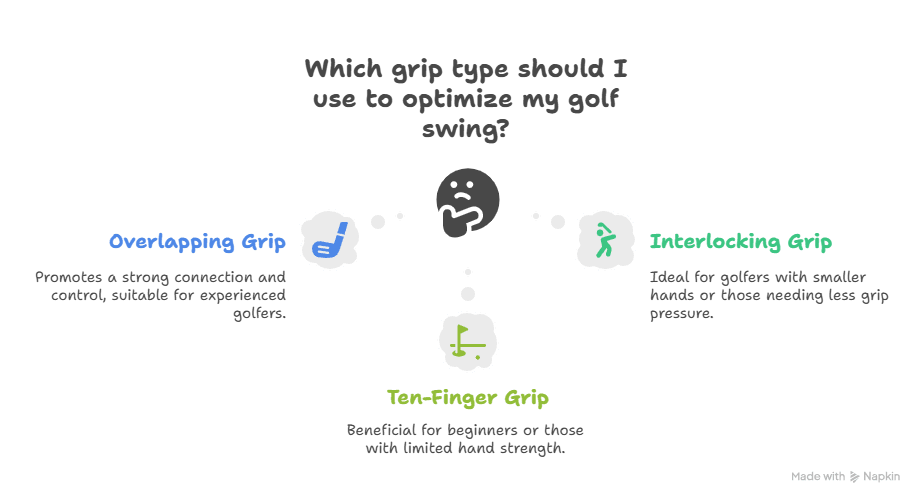
The overlapping grip is just as popular as peanut butter and jelly; it's like the standard choice for golfers. When you do this, the pinky finger of your trailing hand (the right hand for right-handed players) lies on top of the index finger of your lead hand. This overlap keeps your hands steady during the swing, which makes the motion more cohesive. It's hard to juggle when you have mittens on, right? The overlapping grip makes sure that your hands work together perfectly, which gives you more control over your shots.
If you have small hands or just like the way your fingers feel when they are more joined, you might want to try the interlocking approach. This is how it works: instead of merely putting one hand on top of the other, you actually weave them together. Your pinky finger will fit snugly against your index finger on the other hand. This method can help both hands stick together and make swings safer—like grabbing onto a roller coaster bar as you're going through loops!
Finding what feels good for you is really important! Everyone's hands are different, just like everyone has their own favorite ice cream flavor (mine is mint chocolate chip). So go ahead and try out both grips at the driving range or even at home when you're practicing. Pay attention to how each grip changes your swing and the way the ball flies. You might be amazed at how much confidence you get from having a grip that feels right.
Did you know that the average golfer's grip is so crucial that it can determine not just their swing, but also their snack choices? A study found that golfers who grip their clubs too tightly tend to reach for nachos instead of healthier options on the turn. So, next time you’re struggling with your grip, remember: loosen up and maybe you'll be reaching for a salad instead of a double cheeseburger! Who knew that mastering your grip could help your waistline too?
And remember: comfort isn’t just about personal preference; it also influences performance. A secure but relaxed grip allows for greater control without tension creeping into those crucial moments before impact. So take some time to find that perfect fit—your future self will thank you when you're sinking putts like a pro!
Once you've got your grip down pat, practice makes perfect! Take some time on the driving range to get used to how it feels while swinging through different shots. Trust me; when you nail that perfect drive off the tee with confidence in your grip, you'll feel like a million bucks.
Stance and Alignment: Setting Up for Success
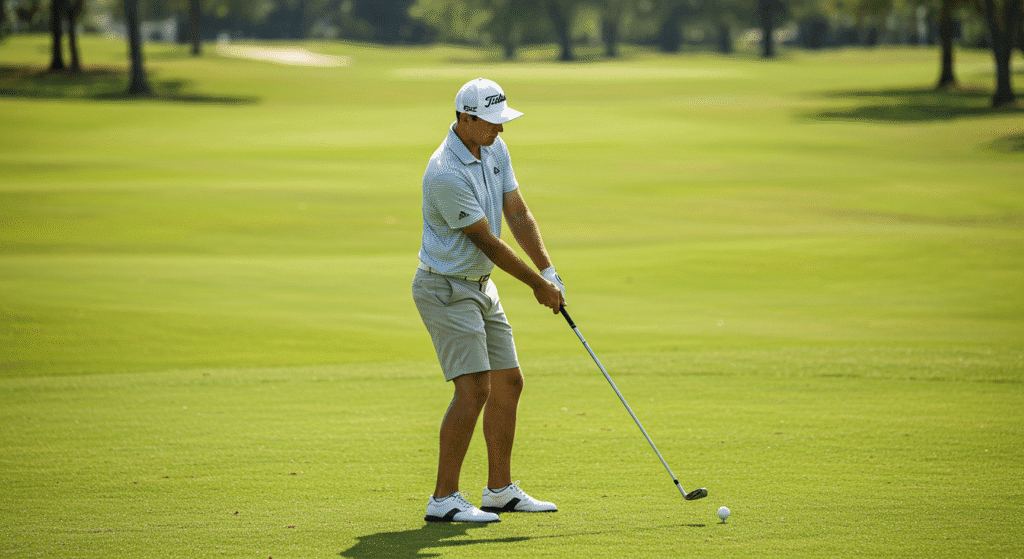
Phil Mickelson: “I don’t know what my handicap is, but it’s not a good one. I just try to have fun out there.“
Now that we've worked on the grip, let's move on to stance and alignment. Imagine this: You're going to take an essential picture, but you notice that you're standing like a flamingo on one leg, which is not good! A strong stance keeps you stable and balanced during your swing.
To begin, stand with your feet shoulder-width apart and your knees slightly bent. This athletic stance is the key to a solid golf swing! Imagine getting ready to rush to the bus, except instead of running, you're getting ready to hit that small white ball down the fairway. This position will help you shift your weight better during your swing, which is important for hitting the ball with power and accuracy.
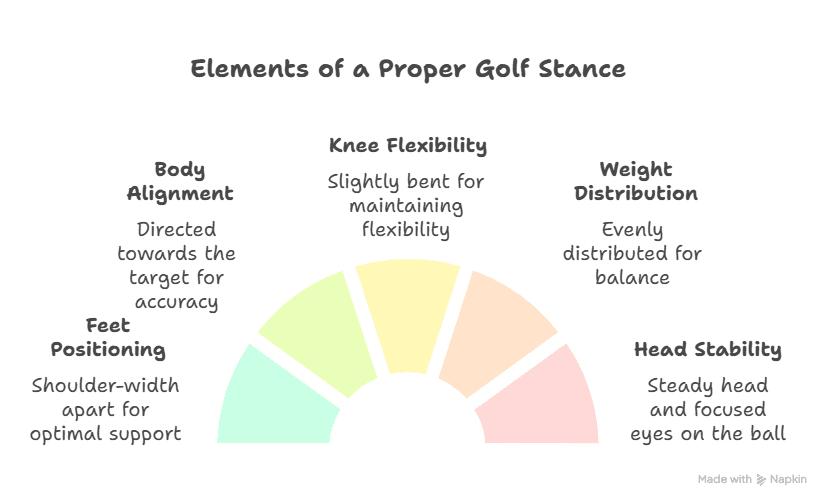
Now let's speak about balance, because no one wants to fall over while swinging like they just tripped over their shoelaces! It's important to make sure that your weight is evenly spread out over both feet. If one side of a seesaw is heavier than the other, it will start to wobble right away. To keep that exact equilibrium, move your weight back and forth a little bit until it feels right. You should feel safe enough to swing without worrying about falling on your face in the grass.
Having a strong base, on the other hand, helps you swing more smoothly. It's easier to move your hips and shoulders during the shot when your knees are bent and your feet are flat on the ground. Everything works together like a well-oiled machine. If you stand too stiffly or too tightly, you can end up swinging like a robot trying to dance at a wedding—awkward and not very successful.
And here's another interesting tip: see how far away you are from the ball. It might mess up your whole game plan if you're too close or too far away. If you're in this athletic posture, the ball should be just inside your lead foot (the left foot for right-handed players) as you gaze down at it. This setup makes it easier to hit the ball cleanly from the right angle.
Did you know that the secret to a perfect golf stance might actually be found in the animal kingdom? Some golfers believe that mimicking a flamingo can improve your balance! The idea is simple: stand on one leg like a flamingo while practicing your swing. Just remember, if you start getting strange looks from fellow golfers or find yourself pecking at the grass for bugs, it might be time to reassess your practice routine. Who knew aligning your body could also align you with nature's quirkiest bird?
So next time you're on the course or hitting balls at the range, remember this golden rule: start with those feet shoulder-width apart and knees slightly bent. Your future swings will thank you when they have stability and balance backing them up! And who knows? Maybe you'll even impress some fellow golfers while doing it!
Next comes alignment. You want to aim those toes parallel to where you'd like the ball to go. It sounds simple enough but can be tricky at first—like trying to walk straight after spinning in circles! Use an object in front of you (like a tee or even a blade of grass) as a visual guide while practicing alignment drills at home or on the course.
The Backswing: Building Momentum
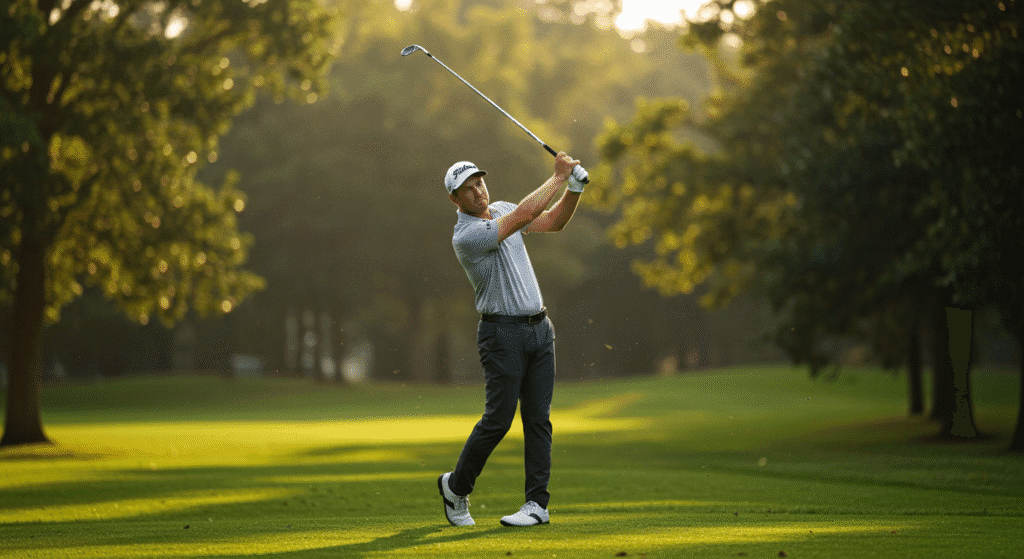
Bobby Jones: “Golf is a game that is played on a five-inch course—the distance between your ears.”
Ahh, now we arrive at my favorite part—the backswing! Think of this as winding up before launching into action; it's crucial for building momentum and power behind each shot. But here’s where things get interesting: many golfers struggle with overthinking their backswing.
To keep things smooth and fluid, focus on rotating your shoulders rather than lifting your arms too high. Imagine drawing back as if pulling back an arrow in a bow—that's how much tension should build up before releasing! As you take that club back behind you, ensure that you're keeping your left arm straight (if you're right-handed). This will help maintain control throughout the motion.
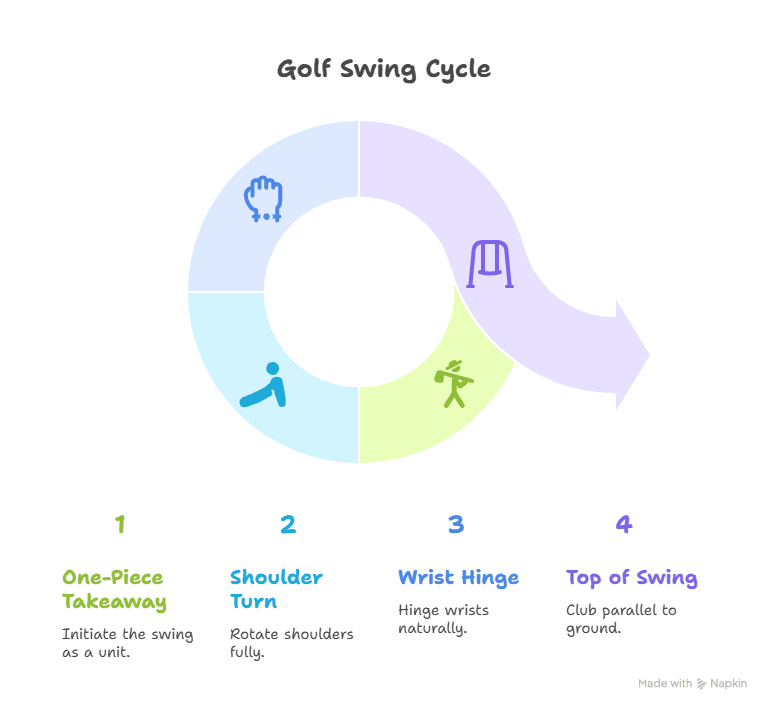
And speaking of control, let's talk about how important tempo is! A little rhythm can change your golf game more than you might think. A slow and steady backswing is like that song you can't stop thinking about; it just feels right! Taking your time lets you be more accurate than if you rush through it like you're attempting to run a marathon in record time. No one wants to run down the fairway only to find their ball lost in the woods.
Picture this: you're standing over the ball, feeling the sun on your back and maybe even hearing birds singing nearby. Take a deep breath instead of swinging wildly like you're being chased by a swarm of bees. Imagine yourself easily gliding through that backswing, with your club moving back like it's on a leisurely walk instead of a furious dash. This calm way of doing things helps you use your muscles correctly and get ready for a more controlled downswing.
Now, let's talk about the times when we all want to hurry things up. We might imagine that swinging faster will help us strike harder or farther. But I've been there, and I can tell you that that's usually a one-way trip to disaster city! When you hurry, you probably give up form and accuracy for speed. It's like trying to bake cookies by turning up the oven temperature. They might cook faster, but they will surely burn!
Did you know that some golfers believe your backswing should be like a slingshot? The idea is that the longer and more dramatic your backswing, the more “momentum” you'll generate—just like pulling back a slingshot before letting it fly! However, this can lead to some interesting situations on the course. There have been reports of golfers accidentally launching their clubs into nearby trees, mistaking their swing for an Olympic event! So remember: build momentum, but maybe keep the slingshot technique reserved for the driving range… or at least avoid aiming for any squirrels!
Finding your perfect tempo can actually help you play better overall on the course, which is interesting. Some golfers say that counting in their heads or using breathing exercises helps them keep that seamless flow during their swing. I've even heard that players hum songs softly to themselves when they get ready to take their shot (although I wouldn't suggest singing in the middle of a swing unless you want people to look at you funny).
So the next time you're swinging like a windmill in a storm, stop and remember that smoothness always beats speed! Accept that steady rhythm; golf is as much about skill as it is about strength. Your future self will be grateful when those shots start landing closer to the pin instead of going off into the unknown!
The Downswing: Time To Shine
Lee Trevino: “You can talk to a fade, but a hook won’t listen.“
Now the downswing! This is when all that built-up energy gets released into hitting that little white ball sitting innocently on its tee (or lying quietly on the fairway). It’s essential not only for distance but also accuracy.
Begin by shifting your weight onto your front foot while simultaneously rotating through with those hips—it’s almost like doing an excited dance move without leaving ground zero! Keep those arms relaxed; they should follow naturally as though being pulled along by gravity itself rather than forcing them downward.
As you approach impact with the ball (cue dramatic music), it’s like being in the final seconds of a nail-biting movie—everything hinges on this moment! Picture it: you’ve put in all that practice, honed your grip and stance, and now here comes the climax. You want to ensure everything is aligned perfectly because, honestly, nobody wants another slice heading toward someone else's picnic lunch! Trust me; I've seen it happen too many times, and let’s just say those folks weren't thrilled about their sandwiches becoming target practice.
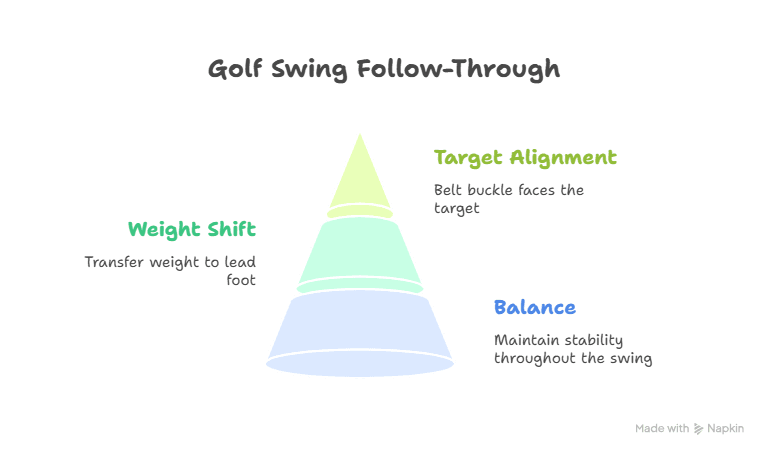
Focus is very important right now. You should be staring at that small white ball like it's the last cookie in the container. I mean, who wouldn't pay attention to that? Your shoulders should be parallel to your target line, your hips should be in the ideal place, and your head should be steady. It's like a dance where everything has to move together. If one thing goes wrong, you might launch the golf ball into space instead of down the fairway.
Let's talk about your arms and hands now that this is a big deal. As you get ready for the hit, they should function together like a well-oiled machine instead of two youngsters arguing over the last piece of cake. You need to let go of your hands at just the perfect time. If you hang on too long, you can miss your shot, and if you let go too soon, your shot might go off course faster than a cat chasing a laser pointer!
And since we're on the subject of alignment, don't forget how crucial it is to keep your posture right the whole time. You want to be steady but also able to move, like a tree that sways gently in the breeze instead of going crazy in a storm. If you can keep that balance, you won't lean back or lunge forward after impact, which can mess up the path of your shot.
When you hit the ball (and yes, cue more dramatic music!), keep in mind that what you do after you hit it is just as essential as what you do when you hit it. A good follow-through not only looks good, but it also helps you hit the ball farther and more accurately. After you strike that nice spot on your clubface, let your swing go through like it should. It's like finishing an enormous book in style!
Did you know that some golfers treat their downswing like a dramatic movie scene? They believe it's all about building suspense before the big moment! In fact, there are tales of players taking so long on their downswing that spectators start placing bets on whether they’ll actually hit the ball or just take a nap mid-swing. One golfer even said, “My downswing is like a good plot twist—unexpected and leaves everyone wondering what just happened!” So next time you're on the course, remember: while your downswing should be powerful, don’t turn it into an Oscar-worthy performance… unless you’re aiming for laughs instead of birdies!
Approaching impact is no small feat; it's where all your hard work pays off or goes hilariously wrong! By focusing on alignment and maintaining control through each phase—from setup to follow-through—you’ll avoid those embarrassing moments when wayward shots become unintentional gifts for unsuspecting picnickers nearby. Now go out there and swing away with confidence!
Follow-through matters just as much as what happens before contact occurs! After hitting that ball sweetly downrange towards glory (or perhaps just past where last week’s lost balls reside), allow yourself plenty of room for recovery afterward instead of abruptly stopping mid-swing—it shows class!
Practice Makes Perfect: Drills To Try
Arnold Palmer: “The most rewarding things you do in life are often the ones that look like they cannot be done.”
Okay folks—let's talk drills because repetition really does lead us closer toward greatness here! One effective drill involves using alignment sticks placed parallel alongside where you'd ideally want those shots aimed—a great way visually train ourselves until aiming becomes second nature!
Another fantastic technique includes hitting balls with half swings rather than full ones initially because it encourages focusing solely upon form instead worrying about distance immediately, and this honestly takes pressure off significantly as well!
Ever heard of the golfer who practiced so much that he accidentally became his own caddy? Legend has it, he spent so many hours on the range that when it came time for a tournament, he couldn’t find anyone else to carry his clubs. So, he rigged up a system of pulleys and ropes around his waist to haul them around himself! He said, “If practice makes perfect, I’m just trying to be the first golfer with a personal assistant built right into my belt!” So remember, while practice is essential, don’t take it too far—unless you want to become your own walking golf bag!
Record yourself practicing every now & then—it may feel awkward watching videos later but trust me—you'll see areas needing improvement much clearer than simply relying upon memory alone!
Mastering golf swing techniques isn’t rocket science but requires dedication & willingness put forth effort consistently every single round played moving forward—and hey if I can learn how navigate crazy twists life throws our way while still enjoying this beautiful sport? So can YOU!!
Featured Snippet: Mastering your golf swing begins with the right fundamentals—grip, stance, backswing, downswing, and follow-through. By perfecting hand placement, maintaining balance, and practicing smooth, consistent motions, golfers can dramatically improve power, accuracy, and control. Consistent drills build confidence and transform every round into a more rewarding experience.
Frequently Asked Questions
What is the most important part of a golf swing?
The grip is the foundation of every great golf swing. A proper grip ensures control, stability, and consistent contact with the ball, setting up better results across every shot.
How can I improve my golf stance?
Maintain a shoulder-width stance with knees slightly bent and weight evenly balanced. This creates a stable base for smoother swings and improved accuracy.
What’s the best way to practice my backswing?
Focus on smooth shoulder rotation and steady tempo. Avoid rushing or overextending, and use drills to build consistent rhythm and muscle memory.
How do I add more power to my downswing?
Shift your weight forward and rotate your hips through impact. Keep your arms relaxed and let your body’s momentum generate natural power.
Why is follow-through important in golf?
A proper follow-through ensures balance, accuracy, and distance. It allows energy to flow smoothly through the swing, improving shot consistency and control.
How often should I practice to see improvement?
Practicing three to four times a week with focused drills helps build lasting muscle memory. Consistency is key to steady progress.
What drills can help improve my overall swing mechanics?
Try alignment stick drills, half-swing exercises, and slow-motion swings to refine form and tempo. Recording your swing can also reveal areas to adjust.
Suggested Resources
Golf Swing Basics
https://www.golfdigest.com/story/golf-swing-basics
Improving Your Golf Swing
https://www.pga.com/lessons/improving-your-golf-swing
Understanding Golf Swing Mechanics
https://www.golf.com/instruction/understanding-golf-swing-mechanics

Kevin Collier is an avid golfer and contributing author at AIGolfTips.com, where he shares his passion for the game through expert tips, techniques, and gear reviews. With years of experience on the course, Kevin offers valuable insights for golfers of all skill levels, helping them improve their game and maximize their potential. Whether discussing swing mechanics or the latest in golf technology, Kevin's engaging approach aims to inspire and educate fellow golf enthusiasts to elevate their performance and enjoy every moment on the green.

